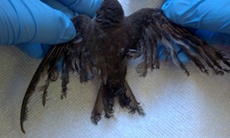‘Flaming birds’ show solar plants are not quite as green as believed
19 Aug 2014
Solar power may not after all be as eco-friendly as thought, as workers at a state-of-the-art solar plant in the Mojave Desert have found that birds flying through the plant's concentrated sun rays ignite in mid-air.
 | |
| Damage to the swallow's wing and tail feathers | Photo: BrightSource Energy |
The workers at the US plants have even created a name for such birds - "streamers," for the smoke plume that comes from birds that burn up midair.
Federal wildlife investigators who visited the BrightSource Energy plant last year and watched as birds burned and fell, reported an average of one such incident, called "streamer", where birds singed or incinerated by the concentrated solar rays plummeted to the ground in a plume of smoke, every two minutes.
The wildlife authorities are urging California officials to halt the operator's application to expand the solar plant until the full extent of the deaths can be assessed. BrightSource claims only 1,000 'flaming birds' per year; but environmental groups claim the figure is a massive 28,000 a year.
The bird kills mark the latest instance in which the quest for clean energy sometimes does environmental harm. Solar farms have been criticized for their impacts on desert tortoises, and wind farms have killed birds, including numerous raptors.
"We take this issue very seriously," said Jeff Holland, a spokesman for NRG Solar of Carlsbad, California, the second of the three companies behind the plant. The third, Google, left comment to its partners.
The $2.2-billion plant, which was launched in February, is at Ivanpah Dry Lake near the California-Nevada border. The operator says it's the world's biggest plant to employ so-called power towers.
More than 300,000 mirrors, each the size of a garage door, reflect solar rays onto three boiler towers each looming up to 40 stories high. The water inside is heated to produce steam, which turns turbines that generate enough electricity for 140,000 homes.
Sun rays sent up by the field of mirrors are bright enough to dazzle pilots flying in and out of Las Vegas and Los Angeles.
Federal wildlife officials said Ivanpah might act as a "mega-trap" for wildlife, with the bright light of the plant attracting insects, which in turn attract insect-eating birds that fly to their death in the intensely focused light rays.
Federal and state biologists call the number of deaths significant, based on sightings of birds getting singed and falling, and on retrieval seeing carcasses with feathers charred.
Wildlife officials who witnessed the phenomena say many of the clouds of smoke were too big to come from anything but a bird, and they add that they saw "birds entering the solar flux and igniting, consequently become a streamer"'
US Fish and Wildlife officials say they want a death toll for a full year of operation.













.jpg)






.jpg)









